Identification of Structural Damage and Damping Performance of a Mega-Subcontrolled Structural System (MSCSS) Subjected to Seismic Action
Abstract
1. Introduction
2. Scope
3. Ground Motion Selection
- In the frequency domain, both the amplitude and the energy distribution of ordinary ground motion are very uniform.
- The frequency band width of the near-fault ground motion is wider than that of the far-fault ground motion, although the majority of the energy distribution in the near-fault ground motion frequency range is concentrated in the low-frequency range, which corresponds to less than 1 Hz.
- Both the amplitude and the energy of ground motions caused by far-fault earthquakes are primarily distributed in the low-frequency range, which is defined as having a frequency of less than 0.75 Hz.
4. Finite Element Model
4.1. Johnson-Cook Model
4.2. MSCSS Configurations
- An MSCSS with dampers, which was proposed by Abdulhadi et al. [13]. Within this configuration, there are 24 viscous dampers, with 8 located within each substructure and situated above the initial megabeam. The viscous damper constant Cv and the damper velocity exponent α are 105 MNsm−1 and 0.3, respectively.
- An MSCSS with an SPSW has an RS-SPSW in the center of the structure. This model was proposed by Muhammad et al. [19]. Figure A1 and Table A1 of Appendix A both show the infill panels’ details along with the section members listed in Table 3.
4.3. Experimental Verification
4.4. Modal Analysis:
5. Stress Nephogram Analysis
5.1. Under Ordinary Ground Motion
5.2. Near-Fault Ground Motion
5.3. Under Far-Fault Ground Motion
5.4. Equivalent Plastic Strain
6. Seismic Performance
6.1. Acceleration Response
6.2. Peak Transient Story Drift
6.3. Residual Story Drift
6.4. Settlement at the Top of the Structure
6.5. Energy Dissipation
7. Conclusions
- Under the effect of high seismic excitations, the stress nephograms of the MSCSSs with and without dampers, as well as the MSCSS fitted with the SPSW, are investigated. This is performed in comparison to the MSCSS without the SPSW. It has been discovered that all MSCSS configurations have a vulnerability in their second and fourth substructures, making them susceptible to failure. In addition, the fourth substructure experiences irreversible plastic strain when subjected to the force of a vibrant earthquake; hence, the MSCSS structure’s section design for the fourth substructure needs to be updated to enhance its seismic response.
- All of the MSCSS configurations’ acceleration response time histories are examined, and comparisons are made between them. In particular, when the MSCSS is subjected to near-fault pulse ground motion, the SPSW-equipped version displays excellent damping performance.
- Under a variety of seismic activities, the interstory drift, plasticity, and damage dissipation of the MSCSS structures are examined. When it comes to resisting the structural vibrations that can be caused by earthquakes, the MSCSS that has been equipped with the SPSW delivers exemplary results.
Author Contributions
Funding
Institutional Review Board Statement
Informed Consent Statement
Conflicts of Interest
Appendix A
| Parameters | 5 m × 4 m Infill Panel | 6.5 m × 4 m Infill Panel | 5 m × 4 m Infill Panel |
|---|---|---|---|
| Thickness | 8 mm | 8 mm | 8 mm |
| Ro | 0.42 m | 0.4 m | 0.42 m |
| Wc | 0.11 m | 0.1 m | 0.11 m |
| Wi | 0.15 m | 0.15 m | 0.15 m |
| Broader at the top and bottom | 0.12 m | 0.2 m | 0.2 m |
| Broader at the right and left sides | 0.15 m | 0.1 m | 0.2 m |
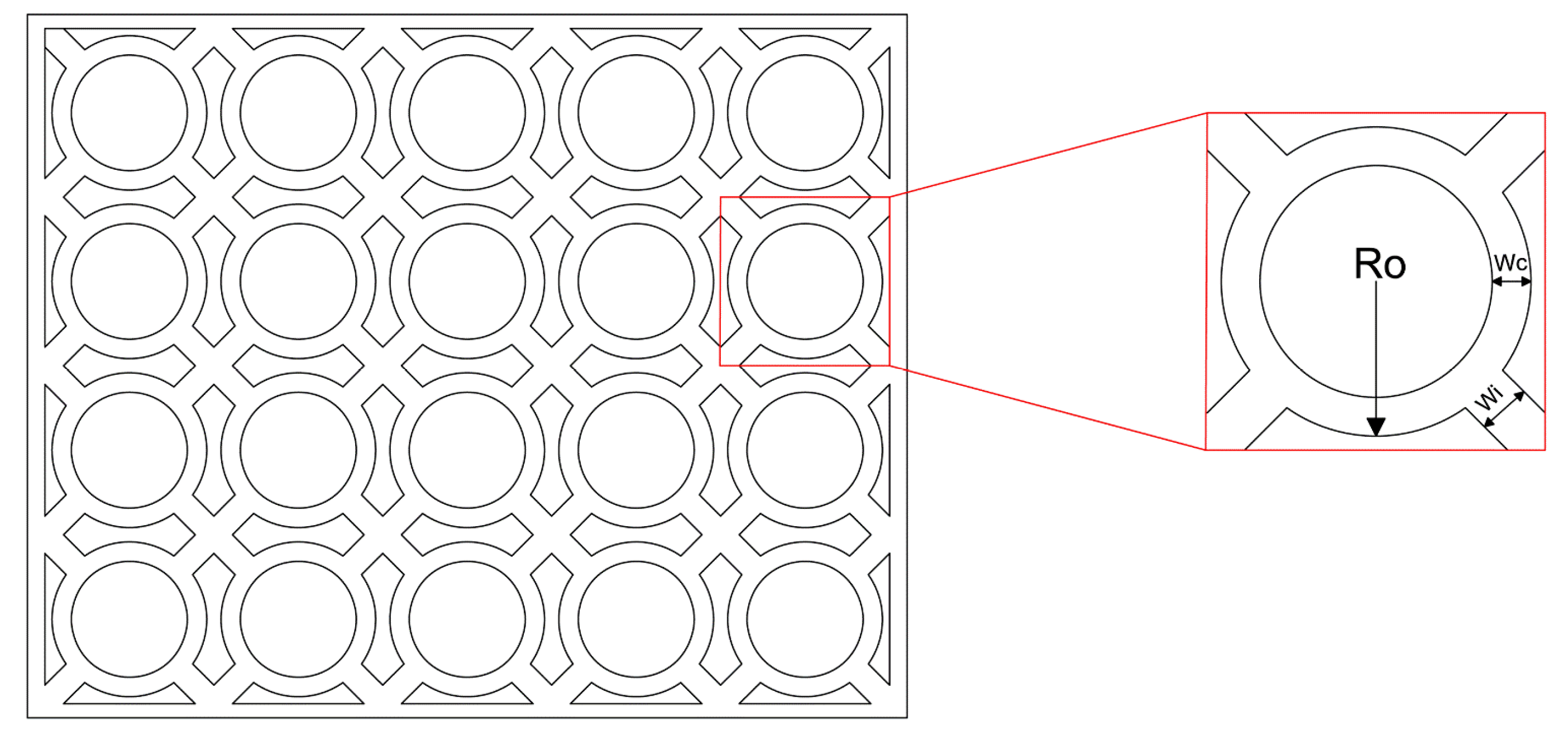
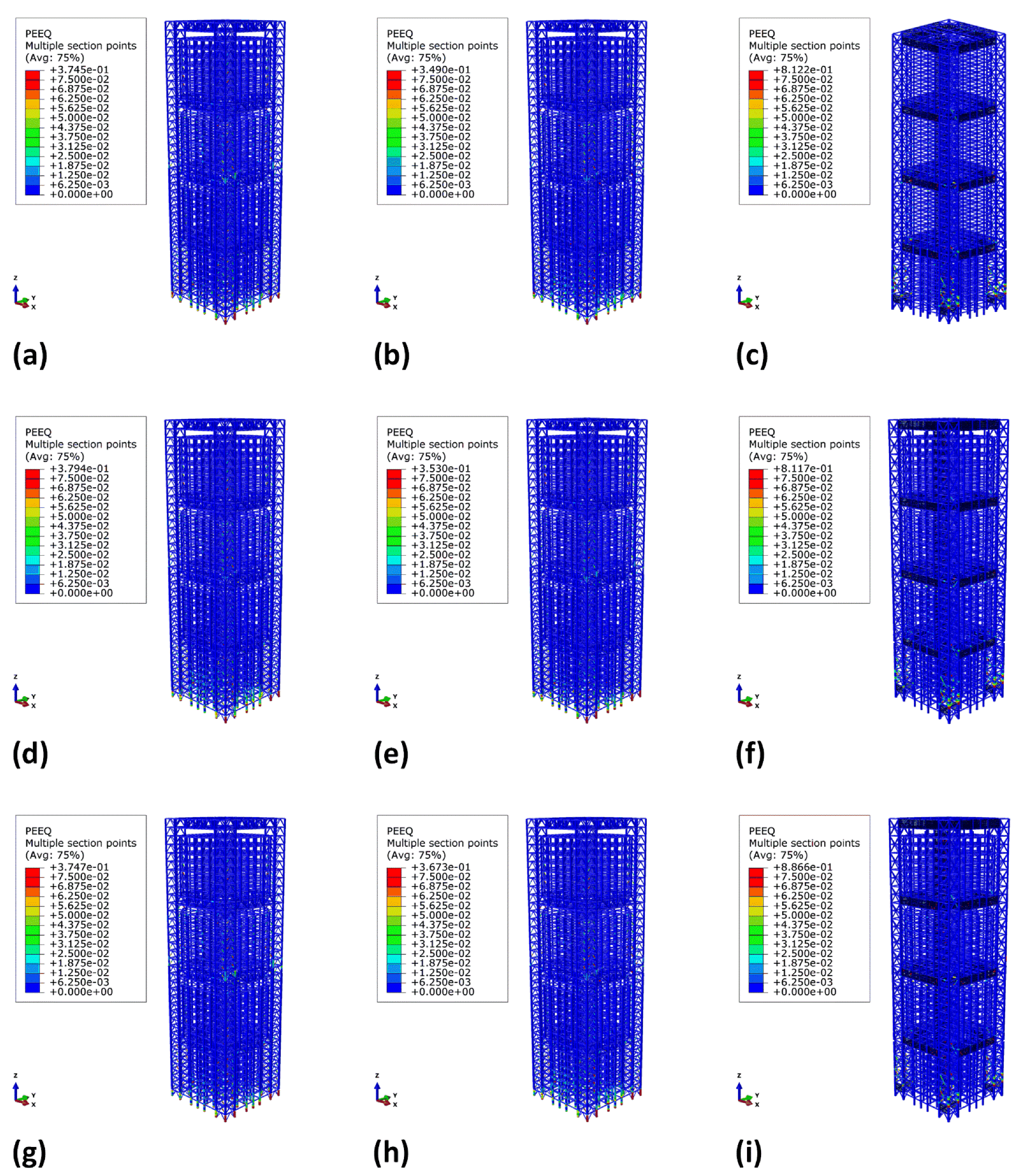
References
- Ali, M.M.; Moon, K.S. Structural Developments in Tall Buildings: Current Trends and Future Prospects. Arch. Sci. Rev. 2007, 50, 205–223. [Google Scholar] [CrossRef]
- CTBUH. The Global Tall Buildings Database of the CTBUH. Available online: http://www.skyscrapercenter.com/ (accessed on 23 March 2020).
- Bhattacharya, S.; Adhikari, S. Experimental validation of soil–structure interaction of offshore wind turbines. Soil Dyn. Earthq. Eng. 2011, 31, 805–816. [Google Scholar] [CrossRef]
- Zhang, Z.; Nielsen, S.R.K.; Blaabjerg, F.; Zhou, D. Dynamics and Control of Lateral Tower Vibrations in Offshore Wind Turbines by Means of Active Generator Torque. Energies 2014, 7, 7746–7772. [Google Scholar] [CrossRef]
- Feng, M.Q.; Mita, A. Vibration Control of Tall Buildings Using Mega SubConfiguration. J. Eng. Mech. 1995, 121, 1082–1088. [Google Scholar] [CrossRef]
- Chai, W.; Feng, M.Q. Vibration control of super tall buildings subjected to wind loads. Int. J. Non-linear Mech. 1997, 32, 657–668. [Google Scholar] [CrossRef]
- Lan, Z.; Fang, L.; Wang, X. Multifunctional shock-absorption system of RC megaframe structures. Ind. Constr. 2002, 32, 1–4. [Google Scholar]
- Xun’An, Z.; Dong, W.; Jiesheng, J. The controlling mechanism and the controlling effectiveness of passive mega-sub-controlled frame subjected to random wind loads. J. Sound Vib. 2005, 283, 543–560. [Google Scholar] [CrossRef]
- Zhang, X.; Zhang, J.; Wang, D.; Jiang, J. Controlling Characteristics of Passive Mega-Subcontrolled Frame Subjected to Random Wind Loads. J. Eng. Mech. 2005, 131, 1046–1055. [Google Scholar] [CrossRef]
- Lian, Y.; Zhang, X.; Sheldon, C. Damping characteristics of friction damped braced frame and its effectiveness in the mega-sub controlled structure system. Earthq. Eng. Eng. Vib. 2007, 6, 171–181. [Google Scholar] [CrossRef]
- Qin, X.; Zhang, X.; Sheldon, C. Study on semi-active control of mega-sub controlled structure by MR damper subject to random wind loads. Earthq. Eng. Eng. Vib. 2008, 7, 285–294. [Google Scholar] [CrossRef]
- Zhang, X.; Qin, X.; Cherry, S.; Lian, Y.; Zhang, J.; Jiang, J. A New Proposed Passive Mega-Sub Controlled Structure and Response Control. J. Earthq. Eng. 2009, 13, 252–274. [Google Scholar] [CrossRef]
- Abdulhadi, M.; Xun’an, Z.; Fan, B.; Moman, M. Design, Optimization and Nonlinear Response Control Analysis of the Mega Sub-Controlled Structural System (MSCSS) Under Earthquake Action. J. Earthq. Tsunami 2020, 14, 2050013. [Google Scholar] [CrossRef]
- Abdulhadi, M.; Xun’An, Z.; Fan, B.; Moman, M. Evaluation of Seismic Fragility Analysis of the Mega Sub-Controlled Structural System (MSCSS). J. Earthq. Tsunami 2020, 14, 2050025. [Google Scholar] [CrossRef]
- Wang, X.; Zhang, X.; Shahzad, M.M.; Wang, T. Research on dynamic response characteristics and control effect of mega-sub controlled structural system under long-period ground motions. Structures 2021, 29, 225–234. [Google Scholar] [CrossRef]
- Wang, X.; Zhang, X.; Shahzad, M.M.; Shi, X. Research on the disaster prevention mechanism of mega-sub controlled structural system by vulnerability analysis. Structures 2021, 33, 4481–4491. [Google Scholar] [CrossRef]
- Abdulhadi, M.; Xun’an, Z.; Fan, B.; Moman, M. Substructure design optimization and nonlinear responses control analysis of the mega-sub controlled structural system (MSCSS) under earthquake action. Earthq. Eng. Eng.Vib. 2021, 20, 687–704. [Google Scholar] [CrossRef]
- Shahzad, M.M.; Zhang, X.; Wang, X.; Abdulhadi, M.; Wang, T.; Xiao, Y. Response control analysis of a new mega-subcontrolled structural system (MSCSS) under seismic excitation. Struct. Des. Tall Spec. Build. 2022, 31, e1935. [Google Scholar] [CrossRef]
- Shahzad, M.M.; Zhang, X.; Wang, X.; Abdulhadi, M.; Xiao, Y.; Fan, B. Plastic Deformation Analysis of a New Mega-Subcontrolled Structural System (MSCSS) Subjected to Seismic Excitation. Buildings 2022, 12, 987. [Google Scholar] [CrossRef]
- Shahzad, M.M.; Zhang, X.; Wang, X.; Abdulhadi, M. Comparative response assessment of different steel plate shear walls (SPSWs) under near-field ground motion. J. Constr. Steel Res. 2022, 190, 107147. [Google Scholar] [CrossRef]
- Kim, M.; Song, J. Near-Real-Time Identification of Seismic Damage Using Unsupervised Deep Neural Network. J. Eng. Mech. 2022, 148, 04022006. [Google Scholar] [CrossRef]
- Krishnan, S.; Muto, M. Mechanism of Collapse of Tall Steel Moment-Frame Buildings under Earthquake Excitation. J. Struct. Eng. 2012, 138, 1361–1387. [Google Scholar] [CrossRef]
- Xu, Y.; Wei, S.; Bao, Y.; Li, H. Automatic seismic damage identification of reinforced concrete columns from images by a region-based deep convolutional neural network. Struct. Control Health Monit. 2019, 26, e2313. [Google Scholar] [CrossRef]
- Wu, J.; Qi, C.; Zhang, F.; Lei, Y.; Zheng, Z. State-Input System Identification of Tall Buildings under Unknown Seismic Excitations Based on Modal Kalman Filter with Unknown Input. J. Aerosp. Eng. 2021, 34, 04021040. [Google Scholar] [CrossRef]
- Fan, B.; Zhang, X.; Xiao, Y.; Abdulhadi, M.; Wang, X.; Shahzad, M.M. Failure Mode and Optimization for MSCSS with LRBs Based on IDA Method. Buildings 2022, 12, 998. [Google Scholar] [CrossRef]
- Biondini, F.; Frangopol, D.M. Life-Cycle Performance of Structural Systems under Uncertainty. In Proceedings of the Structures Congress 2014, Boston, MA, USA, 3–5 April 2014. [Google Scholar] [CrossRef]
- Bai, Y.; Ma, Y.; Yang, Q.; Florez-Lopez, J.; Li, X.; Biondini, F. Earthquake-induced damage updating for remaining-life assessment of steel frame substructure systems. Mech. Syst. Signal Process. 2021, 159, 107782. [Google Scholar] [CrossRef]
- Lignos, D.G.; Krawinkler, H. Deterioration Modeling of Steel Components in Support of Collapse Prediction of Steel Moment Frames under Earthquake Loading. J. Struct. Eng. 2011, 137, 1291–1302. [Google Scholar] [CrossRef]
- Saiprasertkit, K.; Hanji, T.; Miki, C. Fatigue strength assessment of load-carrying cruciform joints with material mismatching in low- and high-cycle fatigue regions based on the effective notch concept. Int. J. Fatigue 2012, 40, 120–128. [Google Scholar] [CrossRef]
- Bai, Y.; Shi, Y.; Deng, K. Collapse analysis of high-rise steel moment frames incorporating deterioration effects of column axial force–bending moment interaction. Eng. Struct. 2016, 127, 402–415. [Google Scholar] [CrossRef]
- Zhang, Z.; Feng, R.; Chen, Y. Theoretical analysis of the mechanical behavior of double-ring joints under pure bending, bending-shear and eccentric loading conditions. Eng. Struct. 2021, 232, 111854. [Google Scholar] [CrossRef]
- Ma, H.; Ma, Y.; Fan, F.; Zhang, Y. Failure mechanism and design method of reticulated shells considering joint damage accumulation effect under earthquake load. Structures 2022, 39, 667–678. [Google Scholar] [CrossRef]
- Loh, C.-H.; Mao, C.-H.; Huang, J.-R.; Pan, T.-C. System identification and damage evaluation of degrading hysteresis of reinforced concrete frames. Earthq. Eng. Struct. Dyn. 2011, 40, 623–640. [Google Scholar] [CrossRef]
- Avci, O.; Abdeljaber, O.; Kiranyaz, S.; Hussein, M.; Gabbouj, M.; Inman, D.J. A review of vibration-based damage detection in civil structures: From traditional methods to Machine Learning and Deep Learning applications. Mech. Syst. Signal Process. 2021, 147, 107077. [Google Scholar] [CrossRef]
- ASCE/SEI 7–16; Minimum Design—Loads and Associated Criteria for Buildings and Other Structures. American Society of Civil Engineers: Reston, VA, USA, 2016.
- Kawashima, K.; Aizawa, K. Bracketed and normalized durations of earthquake ground acceleration. Earthq. Eng. Struct. Dyn. 1989, 18, 1041–1051. [Google Scholar] [CrossRef]
- ASCE/SEI 41-17; Seismic Evaluation and Retrofit of Existing Buildings. American Society of Civil Engineers: Reston, VA, USA, 2017.
- Lilhanand, K.; Tseng, W. Generation of synthetic time histories compatible with multiple-damping design response spectra. In Proceedings of the Transactions of the 9th International Conference on Structural Mechanics in Reactor Technology, Lausanne, Switzerland, 17–21 August 1987; Volume K1. [Google Scholar]
- Lilhanand, K.; Tseng, W.S. Development and application of realistic earthquake time histories compatible with multiple-damping design spectra. In Proceedings of the 9th World Conference on Earthquake Engineering, Tokyo, Japan, 2–9 August 1988; Volume 2, pp. 819–824. [Google Scholar]
- Abrahamson, N. Non-stationary spectral matching. Seismol. Res. Lett. 1992, 63, 30. [Google Scholar]
- Hancock, J.; Watson-Lamprey, J.; Abrahamson, N.A.; Bommer, J.J.; Markatis, A.; McCOYH, E.; Mendis, R. An improved method of matching response spectra of recorded earthquake ground motion using wavelets. J. Earthq. Eng. 2006, 10, 67–89. [Google Scholar] [CrossRef]
- Driver, R.G. Seismic Behaviour of Steel Plate Shear Walls. Doctoral Thesis, Departement of Civil and Environmental Engineering, University of Alberta, Edmonton, AB, Canada, 1997. [Google Scholar]
- Li, X.; Summers, D.; Rupert, G.; Santi, P. Experimental investigation on the breakage of hard rock by the PDC cutters with combined action modes. Tunn. Undergr. Space Technol. 2001, 16, 107–114. [Google Scholar] [CrossRef]
- Schwer, L. Optional Strain-Rate Forms for the Johnson Cook Constitutive Model and the Role of the parameter Epsilon_0. In Proceedings of the 6th European LS-DYNA Users’ Conference, Gothenburg, Sweden, 28–30 May 2007; pp. 1–17. [Google Scholar]
- Buchely, M.F.; Ganguly, S.; Van Aken, D.C.; Omalley, R.; Lekakh, S.; Chandrashekhara, K. Experimental Development of Johnson–Cook Strength Model for Different Carbon Steel Grades and Application for Single-Pass Hot Rolling. Steel Res. Int. 2020, 91, 1900670. [Google Scholar] [CrossRef]
- Wei, Z.; Zhang, X.-A.; Sun, F.; Wang, W.Y. Digital Twin Assistant Active Design and Optimization of Steel Mega-Sub Controlled Structural System under Severe Earthquake Waves. Materials 2022, 15, 6382. [Google Scholar] [CrossRef]
- Villarreal, K.; Wilson, C.; Abdullah, M. Effects of MR Damper Placement on Structure Vibration Parameters. 2004. Available online: https://citeseerx.ist.psu.edu/viewdoc/download?doi=10.1.1.507.2724&rep=rep1&type=pdf (accessed on 24 February 2022).
- Wilson, C.M.D. Fuzzy Control of Magnetorheological Dampers for Vibration Reduction Of Seismically Excited Structures. Ph.D. Thesis, Department of Civil and Environmental Engineering, The Florida State University, Tallahassee, FL, USA, 2005. [Google Scholar]



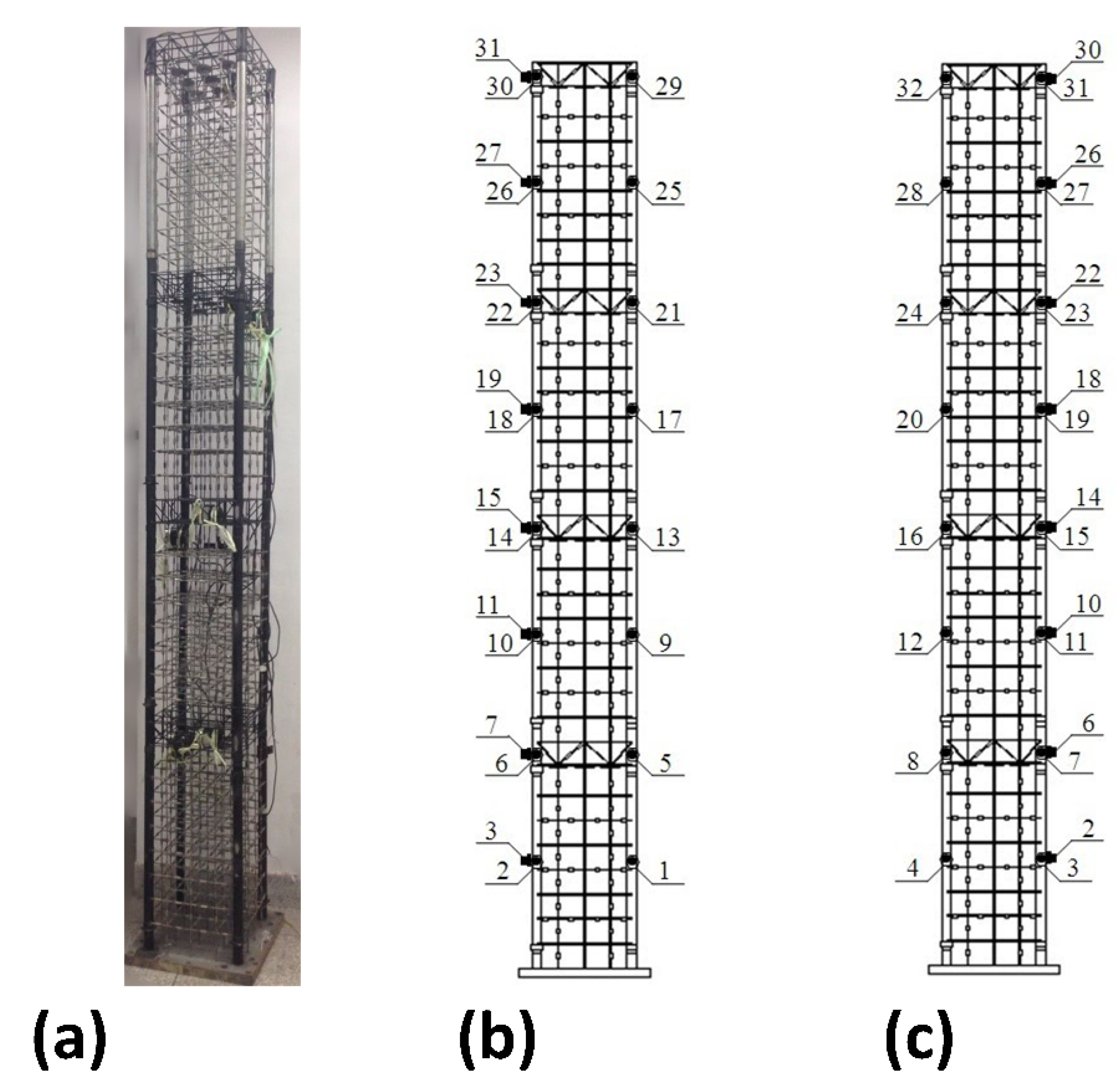
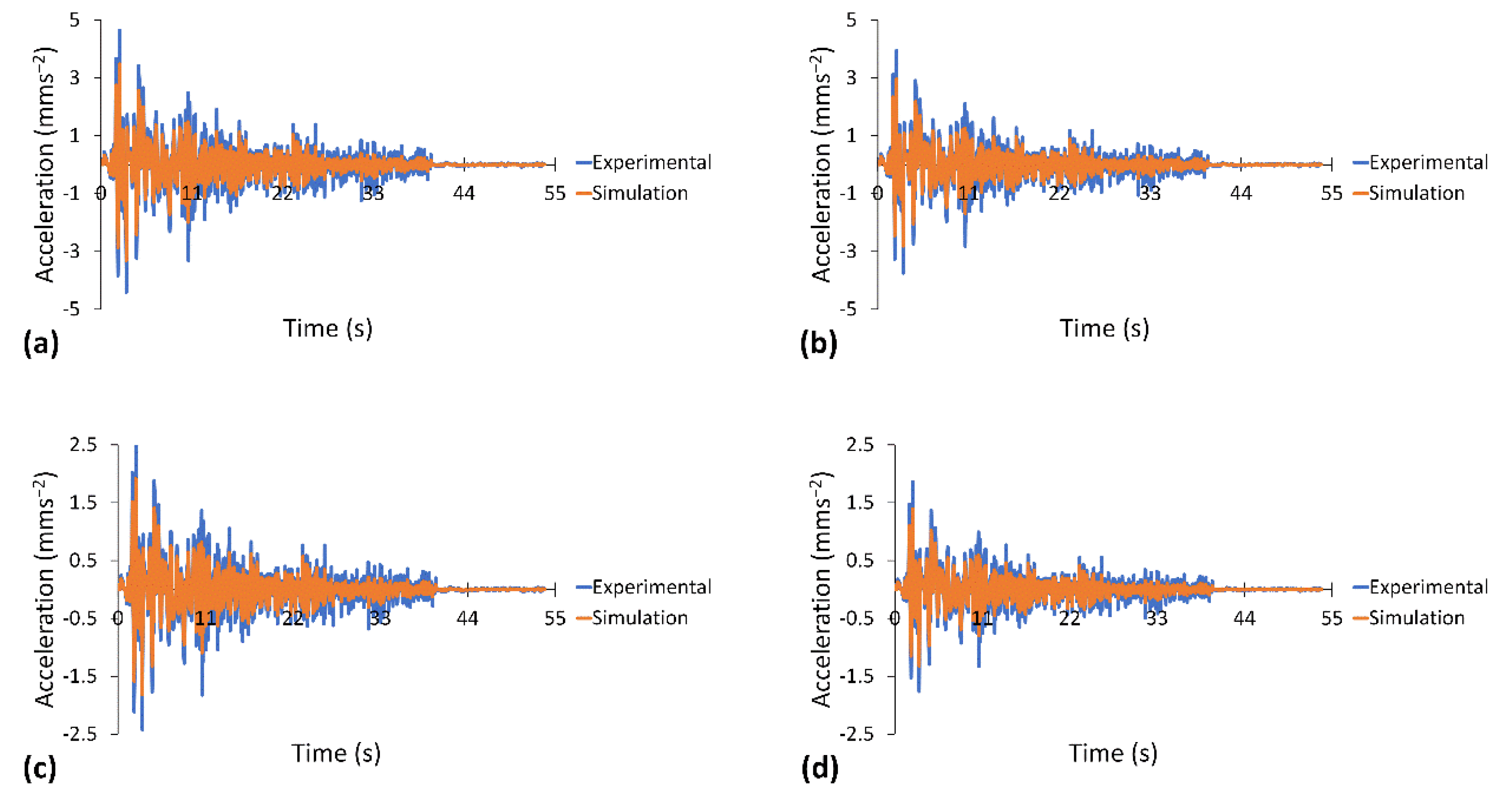


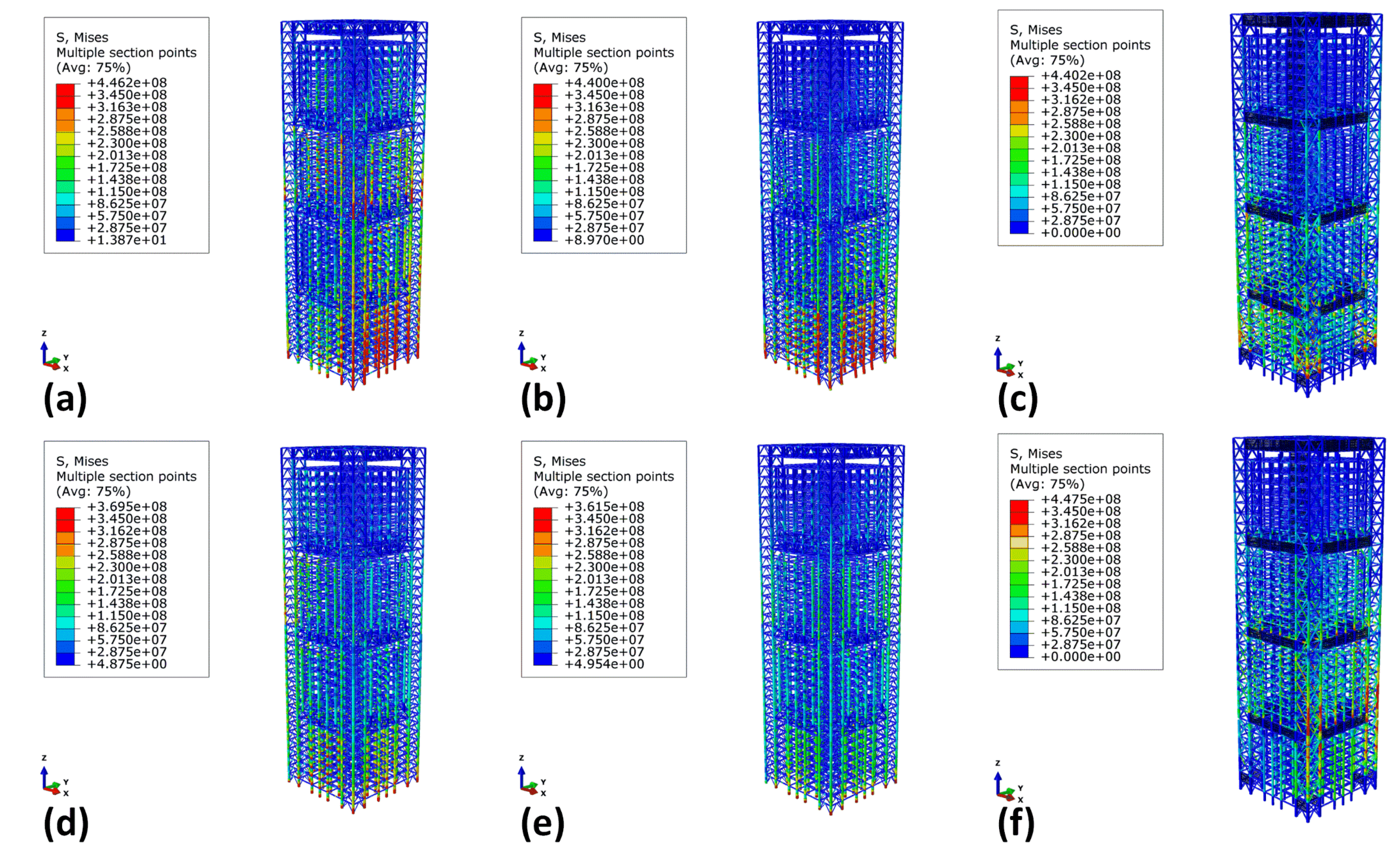

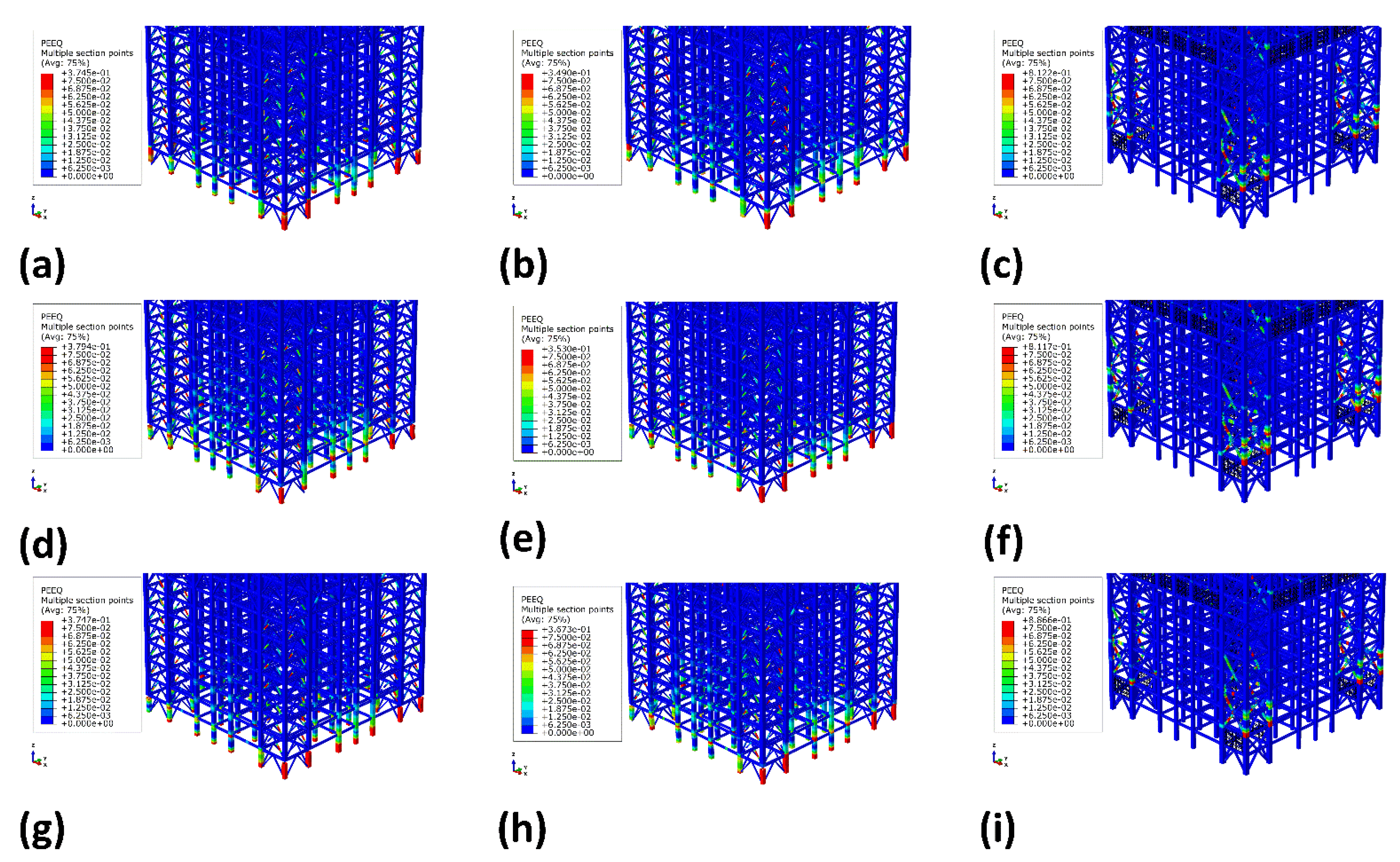
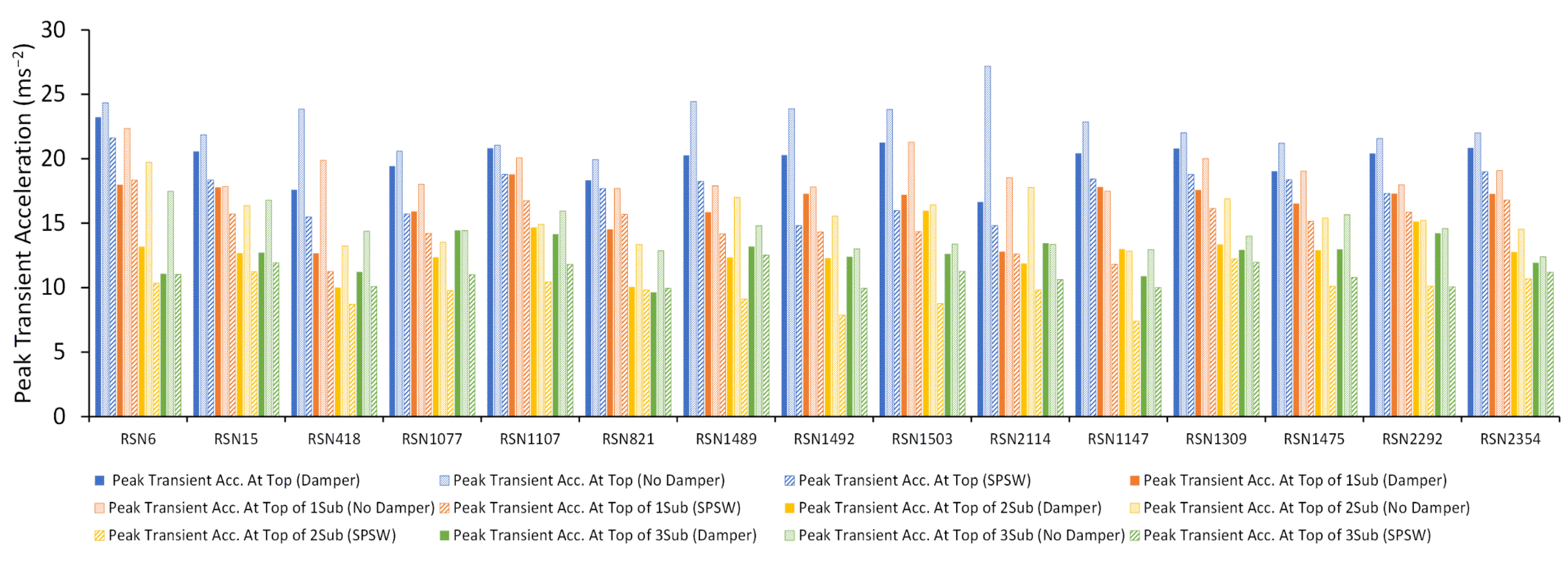
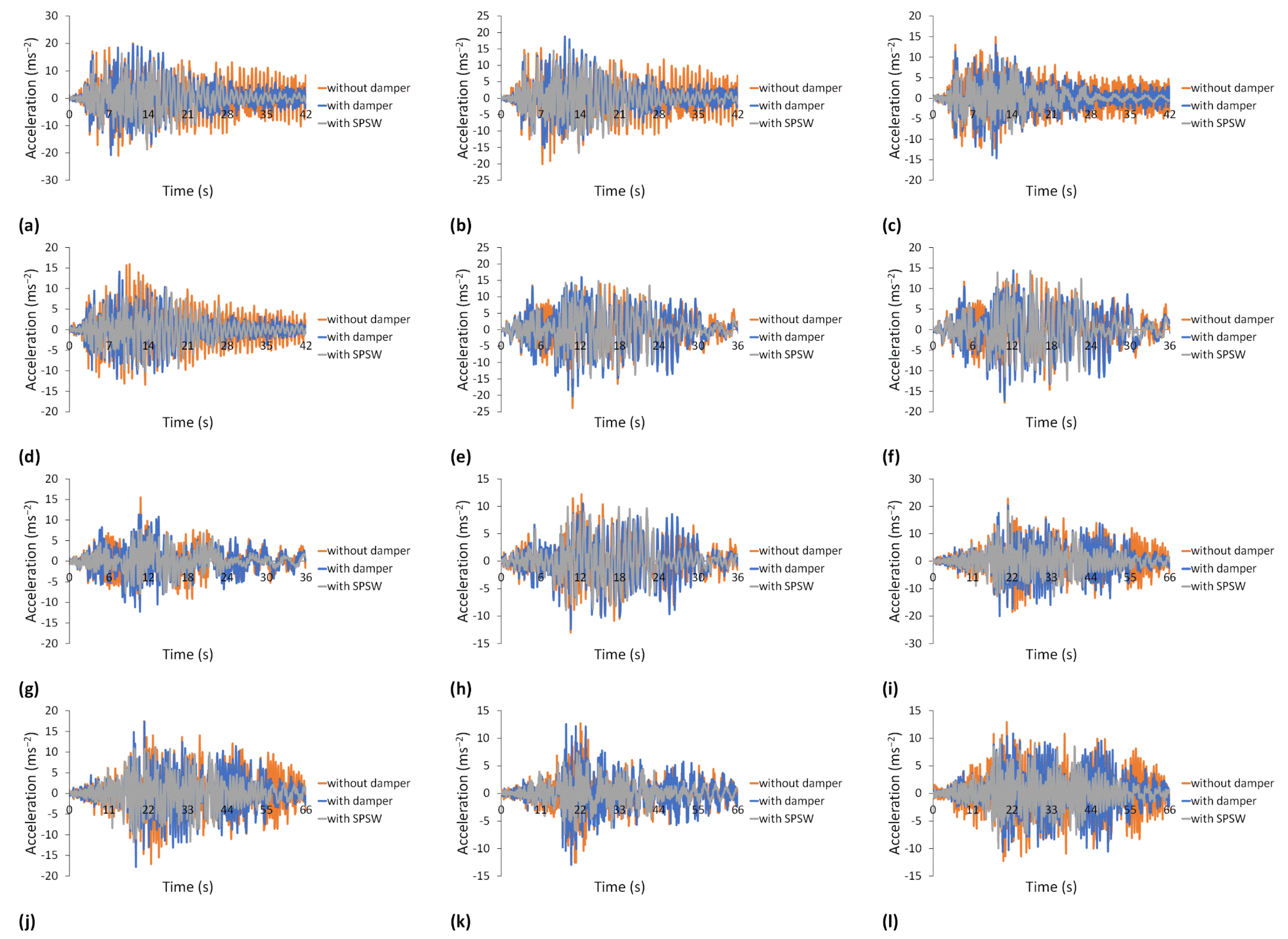

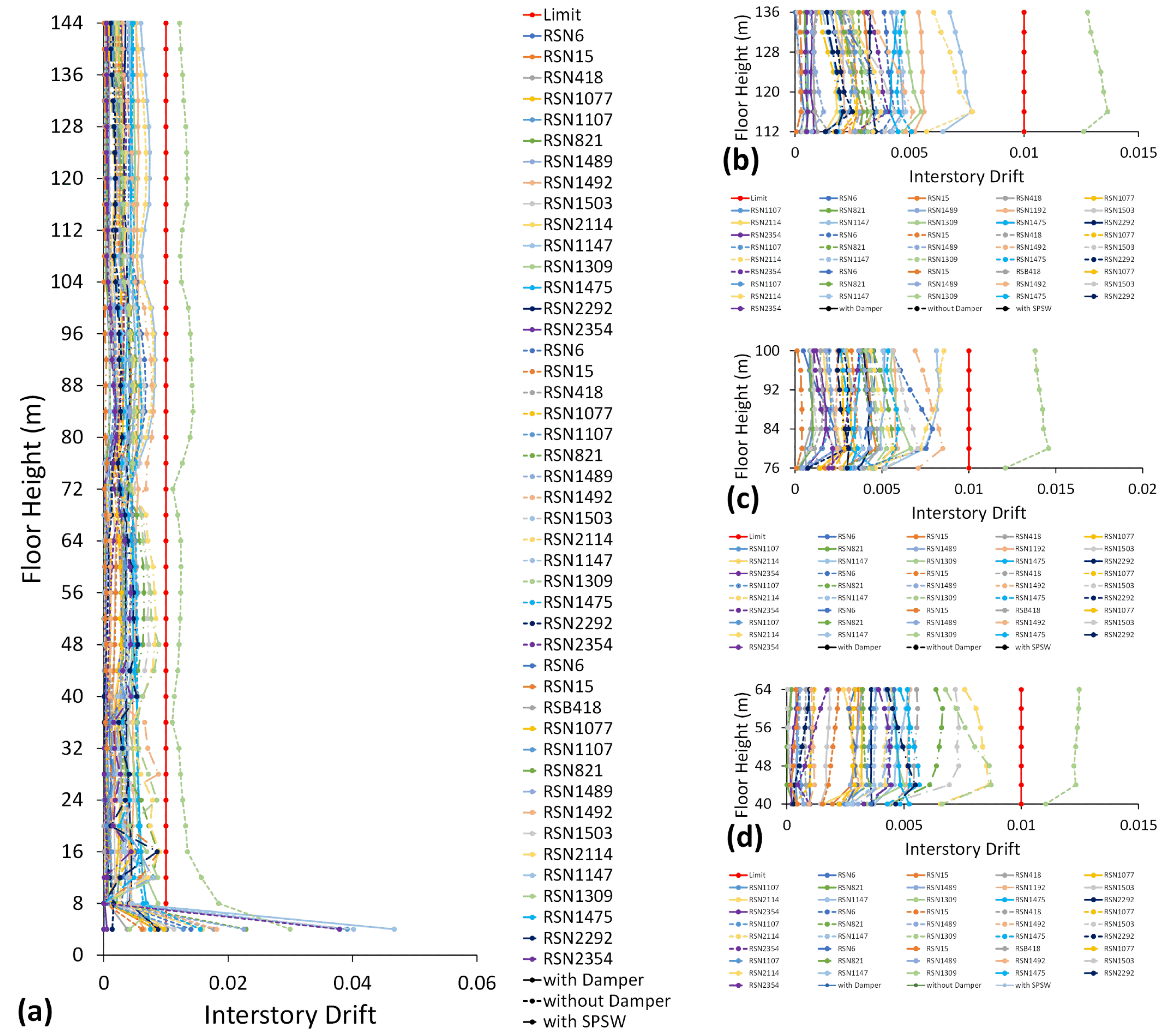
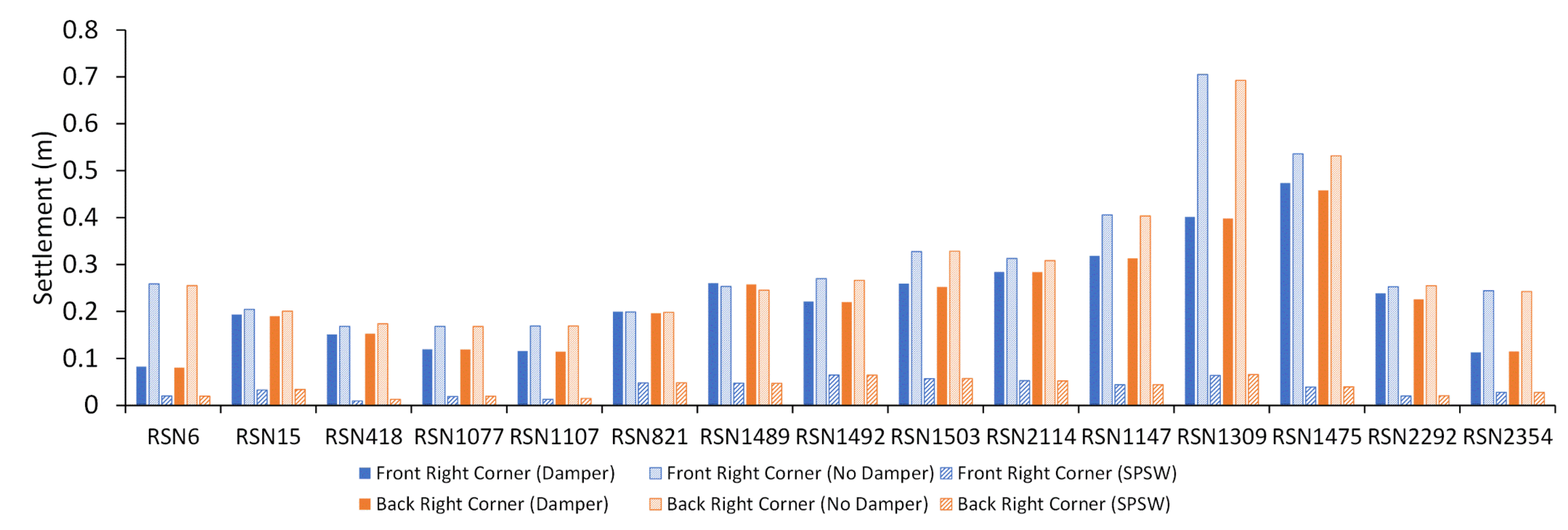

| Classification | Event | Year | Station | RSN | Mw | Mechanism | Rjb (km) | Rrup (km) | Arias Intensity (ms−1) | Tp (s) |
|---|---|---|---|---|---|---|---|---|---|---|
| Ordinary | Imperial Valley-02 | 1940 | El Centro Array #9 | 6 | 6.95 | Strike slip | 6.09 | 6.09 | 1.6 | - |
| Kern County | 1952 | Taft Lincoln School | 15 | 7.36 | Reverse | 38.42 | 38.89 | 0.6 | - | |
| Coalinga-07 | 1983 | Coalinga-14th and Elm (Old CHP) | 418 | 5.21 | Reverse | 7.31 | 10.89 | 1.4 | - | |
| Northridge-01 | 1994 | Santa Monica City Hall | 1077 | 6.69 | Reverse | 17.28 | 26.45 | 2.8 | - | |
| Kobe | 1995 | Kakogawa | 1107 | 6.9 | Strike slip | 22.5 | 22.5 | 1.7 | - | |
| Near-fault | Erzican | 1992 | Erzincan | 821 | 6.69 | Strike slip | 0.0 | 4.38 | 1.8 | - |
| Chi-Chi | 1999 | TCU049 | 1489 | 7.62 | Reverse Oblique | 3.76 | 3.76 | 1.4 | 10.22 | |
| Chi-Chi | 1999 | TCU052 | 1492 | 7.62 | Reverse Oblique | 0.0 | 0.66 | 2.9 | 11.956 | |
| Chi-Chi | 1999 | TCU065 | 1503 | 7.62 | Reverse Oblique | 0.57 | 0.57 | 7.7 | 5.74 | |
| Denali | 2002 | TAPS Pump Station #10 | 2114 | 7.9 | Strike slip | 0.18 | 2.74 | 1.9 | 3.157 | |
| Far-fault | Kocaeli | 1999 | Ambarli | 1147 | 7.51 | Strike slip | 68.09 | 69.62 | 1.2 | - |
| Chi-Chi | 1999 | ILA003 | 1309 | 7.62 | Reverse Oblique | 90.62 | 92.81 | 0.2 | - | |
| Chi-Chi | 1999 | TCU026 | 1475 | 7.62 | Reverse Oblique | 56.03 | 56.12 | 0.2 | 8.372 | |
| Chi-Chi | 1999 | ILA056 | 2292 | 5.9 | Reverse | 110.62 | 111.51 | 0.0 | - | |
| Chi-Chi | 1999 | TCU010 | 2354 | 5.9 | Reverse | 108.63 | 108.82 | 0.0 | - |
| Steel | X (MPa) | Y (MPa) | Z | sr | n | d1 | d2 | d3 | d4 | d5 | Tmelt (℃) | Ttrans (℃) | |
|---|---|---|---|---|---|---|---|---|---|---|---|---|---|
| A 36 | 286 | 500 | 0.017 | 0.917 | 0.228 | 0.403 | 1.107 | 0.1 | 0.00961 | 0 | 1430 | 25 | 1 |
| A 992 | 14.426 | 107.491 | 0.2494 | 0.6857 | 0.3896 | 0.352 | 1.892 | 0.00399 | 0.141 | 0 | 1504.44 | 1000 | 0.0399 |
| Member | Section Shape | Section Size (mm) | Area (m2) | Moment of Inertia | Section Modulus | Radius of Gyration | |||
|---|---|---|---|---|---|---|---|---|---|
| Ix (m4) | Iy (m4) | Wx (m3) | Wy (m3) | Rgx (m) | Rgy (m) | ||||
| Megacolumns up to the first megabeam |  | 900 × 900 × 34 × 34 | 0.1178 | 0.0147 | 0.0147 | 0.0328 | 0.0328 | 0.3538 | 0.3538 |
| Megacolumns between the first and second megabeams |  | 800 × 800 × 34 × 34 | 0.1042 | 0.0102 | 0.0102 | 0.0255 | 0.0255 | 0.313 | 0.313 |
| Megacolumns between the second and third megabeams |  | 700 × 700 × 34 × 34 | 0.0906 | 6.713 × 10−3 | 6.713 × 10−3 | 0.0192 | 0.0192 | 0.2722 | 0.2722 |
| Megacolumns between the third and fourth megabeams |  | 600 × 600 × 34 × 34 | 0.077 | 6.165 × 10−3 | 6.165 × 10−3 | 0.0137 | 0.0137 | 0.2315 | 0.2315 |
| Substructural columns up to the first megabeam |  | 700 × 700 × 34 × 34 | 0.0906 | 6.713 × 10−3 | 6.713 × 10−3 | 0.0192 | 0.0192 | 0.2722 | 0.2722 |
| Substructural columns between the first and fourth megabeams |  | 600 × 600 × 34 × 34 | 0.077 | 6.165 × 10−3 | 6.165 × 10−3 | 0.0137 | 0.0137 | 0.2315 | 0.2315 |
| Additional columns |  | 600 × 600 × 34 × 34 | 0.077 | 6.165 × 10−3 | 6.165 × 10−3 | 0.0137 | 0.0137 | 0.2315 | 0.2315 |
| Megabeams 1, 2, and 3 | H | 650 × 550 × 30 × 30 | 0.0507 | 3.687 × 10−3 | 8.332 × 10−4 | 0.0113 | 3.030 × 10−3 | 0.2697 | 0.1282 |
| Megabeam 4 | H | 600 × 300 × 18 × 18 | 0.0219 | 1.426 × 10−3 | 8.13 × 10−5 | 4.388 × 10−3 | 5.42 × 10−4 | 0.2555 | 0.061 |
| Beams between the megacolumns up to the second megabeam | H | 582 × 350 × 20 × 20 | 0.0248 | 1.371 × 10−3 | 1.433 × 10−4 | 4.712 × 10−3 | 8.187 × 10−4 | 0.235 | 0.0759 |
| Beams between the megacolumns from the second to 4th megabeam | H | 500 × 300 × 18 × 18 | 0.0192 | 7.774 × 10−4 | 8.123 × 10−5 | 3.11 × 10−3 | 5.415 × 10−4 | 0.2015 | 0.0651 |
| Bracing in the megacolumns up to megabeam 1 | H | 450 × 350 × 30 × 30 | 0.0327 | 1.076 × 10−3 | 2.153 × 10−4 | 4.782 × 10−3 | 1.23 × 10−3 | 0.1814 | 0.0811 |
| Bracing in the megacolumns above megabeam 1 | H | 350 × 350 × 25 × 25 | 0.025 | 5.193 × 10−4 | 1.79 × 10−4 | 2.967 × 10−3 | 1.023 × 10−3 | 0.1441 | 0.0846 |
| Substructural beams | H | 500 × 350 × 25 × 25 | 0.0288 | 1.178 × 10−3 | 1.792 × 10−4 | 4.711 × 10−3 | 1.024 × 10−3 | 0.2024 | 0.079 |
| Model | Modal Frequency (Hz) | Deviation (%) | |
|---|---|---|---|
| Experimental | Simulated from ABAQUS | ||
| 1 | 5.130 | 5.057 | 1.423 |
| 2 | 5.313 | 5.241 | 1.355 |
| 3 | 9.587 | 8.375 | 12.642 |
| 4 | 13.716 | 13.048 | 4.87 |
| 5 | 14.166 | 13.827 | 2.393 |
| 6 | 21.811 | 20.913 | 4.117 |
| Configuration Name | Modal Time Period (s) | Modal Frequency (Hz) | ||||
|---|---|---|---|---|---|---|
| Mode 1 | Mode 2 | Mode 3 | Mode 1 | Mode 2 | Mode 3 | |
| MSCSS without dampers | 4.555 | 4.509 | 2.817 | 0.220 | 0.222 | 0.355 |
| MSCSS with dampers | 4.553 | 4.508 | 2.814 | 0.220 | 0.222 | 0.355 |
| MSCSS with an SPSW | 3.316 | 3.129 | 1.938 | 0.302 | 0.320 | 0.516 |
Publisher’s Note: MDPI stays neutral with regard to jurisdictional claims in published maps and institutional affiliations. |
© 2022 by the authors. Licensee MDPI, Basel, Switzerland. This article is an open access article distributed under the terms and conditions of the Creative Commons Attribution (CC BY) license (https://creativecommons.org/licenses/by/4.0/).
Share and Cite
Shahzad, M.M.; Zhang, X.; Wang, X. Identification of Structural Damage and Damping Performance of a Mega-Subcontrolled Structural System (MSCSS) Subjected to Seismic Action. Sustainability 2022, 14, 12390. https://doi.org/10.3390/su141912390
Shahzad MM, Zhang X, Wang X. Identification of Structural Damage and Damping Performance of a Mega-Subcontrolled Structural System (MSCSS) Subjected to Seismic Action. Sustainability. 2022; 14(19):12390. https://doi.org/10.3390/su141912390
Chicago/Turabian StyleShahzad, Muhammad Moman, Xun’an Zhang, and Xinwei Wang. 2022. "Identification of Structural Damage and Damping Performance of a Mega-Subcontrolled Structural System (MSCSS) Subjected to Seismic Action" Sustainability 14, no. 19: 12390. https://doi.org/10.3390/su141912390
APA StyleShahzad, M. M., Zhang, X., & Wang, X. (2022). Identification of Structural Damage and Damping Performance of a Mega-Subcontrolled Structural System (MSCSS) Subjected to Seismic Action. Sustainability, 14(19), 12390. https://doi.org/10.3390/su141912390






